 About Author:
About Author:
Aarti Narkhede
Mahakal Institute of Pharmaceutical Studies,
Ujjain, MP
narkhede_aarti@rediffmail.com
ABSTRACT
The use of natural product has increased tremendously in a western world as well as in developing countries or in all over part of world. via this artical therapeutic potential and future prospect of Psidium guajava L. are described. Psidium guajava L. belonging to family, myrtaceae. It is a commen tree and easily found in a tropical countries or area. Traditionally it is a very popular and used from long time in a various system of medicine like, unani, Siddha, homeopathy and Ayurveda. It is used for treatment of many ailments like diarrhea, dysentery, wounds, rheumatism, lungs problems, ulcers, skin infections, vaginal discharge, epilepsy, menstrual pain, sore throat, mouth swelling, cold and cough, toothache and etc. In present time study on antipoliferitive or anticancer activities are undertaken and it is found that anticancer activity of P.Guajava has a four time greater than vincristine.
Now this plant reported for its various biological activities like antidiarrhoeal, antimicrobial, antitussive, antidiabatic, antihypertensive, immunomodulatory activity, antioxidant, hepatoprotactive, antistress, anticance, antiproliferative activity. and this plant holds great attention because of its high therapeutic potential because of high level of phenolic, flavomoids and tannin content and with benefit of its easy availability.
Reference Id: PHARMATUTOR-ART-1598
INTODUCTION
Family: Myrtaceae
Genus: Psidium
Species: guajava
Comman names: Guava, goiaba, guayaba, djamboe, djambu, goavier, gouyave, goyave, goyavier, perala, bayawas, dipajaya jambu, petokal, tokal, guave, guavenbaum, guayave, banjiro, goiabeiro, guayabo.
Part Used: Fruit, leaf, bark.
Description: It is a low evergreen tree or shrub 6 to 25 feet high, with wide-spreading branches and square, downy twigs, is a native of tropical America. It is a common vegetation cover by roads and in waste places in Hawaii. Guava is a tropical and semitropical plant. It is well known in the islands for its edible fruit. It is common in the backyards. The branches are crooked, bringing opposite leaves. The flowers are white, incurved petals, 2 or 3 in the leaf axils, they are fragrant, with four to six petals and yellow anthers. The fruit is small, 3 to 6cm long, pear- shaped, reddish-yellow when ripe.
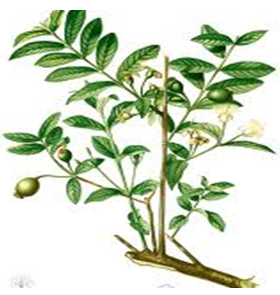
FIG. NO. 1 Psidum guajava linn.
Guava fruit:
Guava certainly is the “Fruit in the News”. Besides its much proven health benefits, the fruit is being discussed lately because of its high Antioxidant levels. Guava (Psidium guajava L.) has always been a very important fruit crop of India. It has always gaine d great respect because of its …
• High nutritive value,
• Easy availability,
• Low economic value,
• Pleasant aroma, and
• Good flavor.
Guava has the second highest content of vitamin C, next to Amla. It is also very high in the soluble fiber ‘’Pectin’’ which cleans and rinses our intestines well. A guava weighing 100g (approx a medium sized guava) would contain 260 mg of Vitamin C which is four time greater than orange.(recommended intake is 40mg per day) and 8.5 gm of dietary fiber (recommended intake is 25 gm to 30 gm per day). Guava is also rich in Carotenoids and Potassium. The nutrient content of fruit differs with the cultivar, stage of maturity and season. Guava is in the true sense a super food.
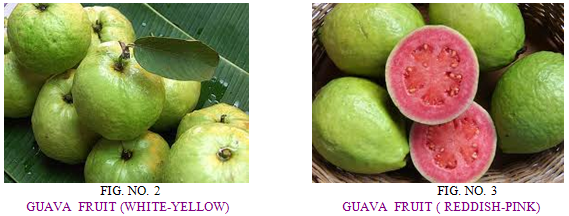
guava bark: Bark light to reddish brown ,thin, smooth ,continuously flaking; root system generally superfied and very extensive,frequently extending well beyond the canopy, there are some deep roots but no distinct taproot.
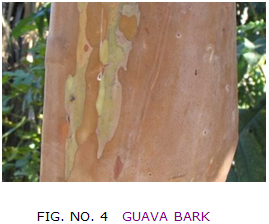
Guava Flowers: Axillary, 1-3-flowered, pedicals about 2cm long, bracts 2, linear, calyx splitting irregulary into 2-4 lobes, whitish and sparsely within;petals 4-5 white, linear-ovate. 2cm long, delicate, stamens numerous, filaments pale white,about 12mm long, erector spreading, another straw colored, ovary inferior.ovules numerous , style about 10 cm long ,stigma green,capitate.

FIG. NO.5 GUAVA FLOWER
Guava leaves: leaves are opposite, simple,stipules absent ,petiole short, 3-10 mm long; blade oblong to elliptic ,5-15 cm ,apex obtuse to bluntly acuminate ,base rounded to subcuneat , margins entir , somewhat thick and leathery, dull grey to yellow-green above, slightly downy below, veins prominent , gland dotted.
Apart from the fruit, guava leaves also have an array of qualities which are healing and curative. Guava leaf is ‘antibacterial’ in nature. Studies conducted in the past have proven the leaves to be helpful in Diabetes. They help regulate blood glucose levels. Guava leaves could also be consumed like any other cooked green leafy vegetable or juice. This would bring nutrition on the platter absolutely free of cost.
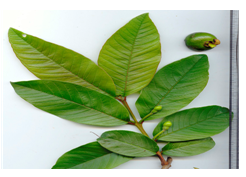
FIG.NO.-6 GUAVA LEAVES
Traditional uses:
This plant seemed worthy of an in depth review. the long history of guava use has led modernday researchers to study guava extracts. Its traditional use against diarrhea, gastroenteritis and other digestive complaints has been validated in numerous clinical studies. there is a strong incentive for further research into the pharmacological activities of P. guajava plant extract against common infectious diseases considering the fact that the plant is readily available in the tropics and within the reach of the local populace.
NOW YOU CAN ALSO PUBLISH YOUR ARTICLE ONLINE.
SUBMIT YOUR ARTICLE/PROJECT AT articles@pharmatutor.org
Subscribe to Pharmatutor Alerts by Email
FIND OUT MORE ARTICLES AT OUR DATABASE
Amazonia–
for diarrhea, dysentery, menstrual disorders, stomachache,vertigo.
Brazil-
For anorexia, cholera, diarrhea, digestive problems, dysentery, gastric insufficiency, inflamed mucous Membranes, laryngitis, mouth(swelling), skin problems, sore throat, ulcers, vaginal discharge.
Cuba-
For colds, dysentery, dyspepsia.
Ghana–
Coughs, diarrhea, dysentery, toothache.
Haiti-
For dysentery, diarrhea, epilepsy, itch, piles, scabies, skin sores, sore throat, stomachache, wounds and as an antiseptic and astringent.
India-
For anorexia, cerebral ailments, childbirth, chorea convulsions, epilepsy, nephritis, jaundice.
Malaya-
For dermatitis, diarrhea, epilepsy, hysteria, menstrual disorders.
Mexico-
For deafness, diarrhea, itch, scabies, stomachache, swelling, ulcer, worms, wounds.
Peru-
For conjunctivitis, cough, diarrhea, digestive problems, dysentery, edema, gout, hemorrhages, gastroenteritis, gastritis, lung problems, PMS, shock, vaginal discharge, vertigo, vomiting, worms.
Philippines–
For sores, wounds and as an astringent.
Trinidad-
For bacterial infections, blood cleansing, diarrhea and dysentery.
HABITATE
* The Psidium guajava L. thrives well at an altitude of 2740 m above sea level.
* It prefers full sun but requires at least partial sunlight.
* The plant grows best in average summer temperatures of over 150 C, but cannot withstand intense heat. Only light frost can be tolerated.
* It produces more fruit in areas with distinct winter season.
* The annual rainfall required is between 1000 to 20000 mm, although it is draught tolerant.
* Tolerates many different soil types, but prefers slightly acidic soils with good drainage.
It tolerates soil pH of 4.5-9.4, but prefers a range of 5-7.
CHEMICAL COMPOSITION
TABLE NO. 1
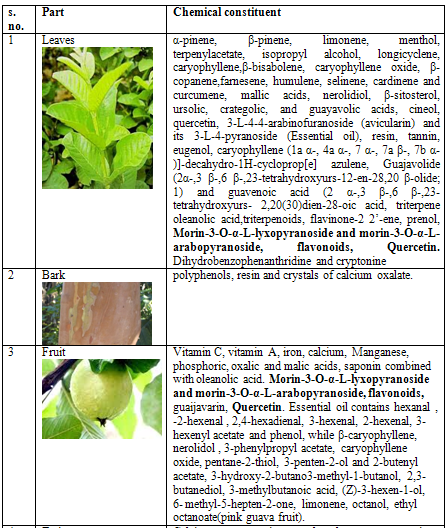
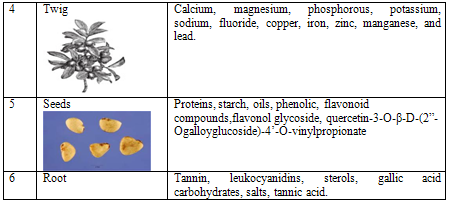
NUTRITIONAL VALUE
Guavas are often included among superfruits ,being rich in dietary fiber, vitamins A and C, folic acid, and the dietary minerals, potassium, copper and manganese. Having a generally broad, low-calorie profile of essential nutrients, A single common guava (P. guajava) fruit contains about four times the amount of vitamin C as an orange.
Guavas contain both carotenoids and polyphenols – the major classes of antioxidant pigments – giving them relatively high potential antioxidant value among plant foods. As these pigments produce the fruit skin and flesh color, guavas that are red-orange have more pigment content as polyphenol, carotenoid and pro-vitamin A,retinoid sources than yellow-green ones.
Nutrition content of Guava
TABLE NO. 2
|
S.no. |
Nutrients |
Quantity |
|
1 |
Calories |
77.86g |
|
2 |
Moisture |
2.8-5.5g |
|
3 |
Crude fiber |
0.9-1.0g |
|
4 |
Protein |
0.1-0.5g |
|
5 |
Fat |
0.43- 0.7g |
|
6 |
Carbohydrates |
9.1-17mg |
|
7 |
Calcium |
17.8-30mg |
|
8 |
phosphorus |
0.30-0.70mg |
|
10 |
Iron |
200-400I.U. |
|
11 |
Carotene(vita-A) |
0.046mg |
|
12 |
Thiamin |
0.03-0.04mg |
|
13 |
Riboflavin |
0.6-1.068mg |
|
14 |
Niacin |
40 I.U. |
|
15 |
Vitamin B3 |
35 I.U. |
|
16 |
Vitamin G4 |
30-50mg |
THERAPEUTIC POTENTIAL
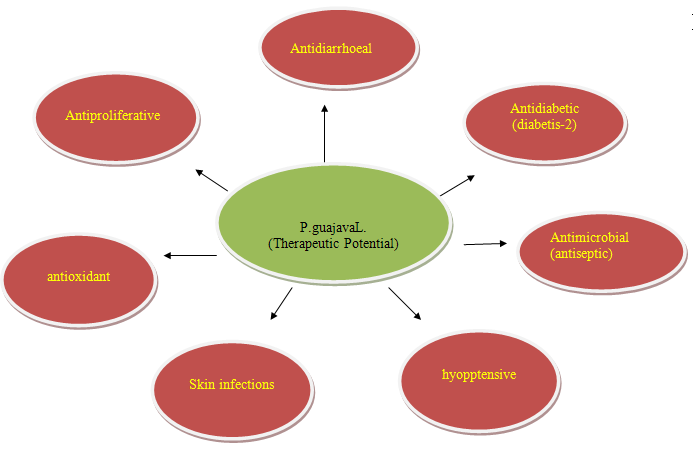
NOW YOU CAN ALSO PUBLISH YOUR ARTICLE ONLINE.
SUBMIT YOUR ARTICLE/PROJECT AT articles@pharmatutor.org
Subscribe to Pharmatutor Alerts by Email
FIND OUT MORE ARTICLES AT OUR DATABASE
ANTIOXIDANT ACTIVITY
An epidemiological study was conducted recently by the National Institute of Nutrition (NIN), Hyderabad (India), to know the antioxidant properties of different fruits. The study included only those fruits that are easily available in the Indian market and are commonly consumed by maximum Indians. The fruits were Guava, Pine-apple, Indian plum, Mango (ripe), Apple, Chiku, Watermelon, Custard apple, Grapes (green), Orange, Papaya (ripe), Pomegranate, Sweetlimeand Banana.
The results showed that out of the 14 fresh fruits, guava and mango were found to be the richest in antioxidants. Anti-oxidant property of guava was found to be 496 mg / 100gm, which is said to be sufficient to get rid of ‘free radicals’ (wear and tear/disease causing chemicals) present in our body. the antioxidant activity of the fruits in the study ranged from as high as 496 mg /100 gm in Guava to as low as 22mg/100gm in pineapple. ‘’Lycopene’’is the potent antioxidant found in abundance in Guava.
A guava provides 2.9 g of Lycopene, an antioxidant that protects healthy cells from toxins that accumulate in the body due to metabolism and environmental pollution. The damaging effect of toxins includes premature aging, cancer development because they damage DNA in charge of growth and development.
Free radicals hasten ageing and are responsible for causing many Cancers and many other degenerative disorders. So, the main objective behind the study was to know the antioxidant properties in naturally occurring fruits that could fight against free radicals.
The study has brought forth the benefit of the natural occurring antioxidants in lowering the risk of degenerative diseases such as Cancer, Diabetes, Atherosclerosis (hardening of blood channels).
Dr Sreeramulu, from the Endocrinology and Metabolism division of the National Institute of Nutrition’s and the lead author of this study, stated that “Natural antioxidants ”have attracted considerable interest among nutritionists, food manufacturers and consumers because of their presumed safety and potential therapeutic value.
Dr Sreeramulu highlighted the importance of the findings saying that “even the commonly available Guava can enrich the Indian diet”. He also added that “We usually believe expensive fruits are the richest source of nutrition. But our extensive research shows that highly economical fruits like ‘’Guava’’ are rich in antioxidant the most that help scavenge free radicals that destroy tissues. The Indian plum, the custard apple and India’s be loved mangoes, all came after guava in antioxidant richness. The study also found that while there is a presence of antioxidant concentrations of just under 500 mg per 100 gm in guava, 330 mg in plum and 135 mg in pomegranate, apples have a quarter of the antioxidants compared with guava and bananas have a tiny fraction with 30 mg per 100gm.
Cellular damage or oxidative injury arising from free radicals or reactive oxygen species (ROS) now appears to be the fundamental mechanism underlying a number of infections, human neurodegenerative disorders, diabetes, inflammation, viral infections, autoimmune pathologies and digestive disorders. Free radicals are generated through normal metabolism of drugs, environmental chemicals and other xenobiotics as well as endogenous chemicals especially stress hormones.
Antioxidant activity-
Dried powdered of Psidium guajava was successively extracted with acetone, methanol and water respectively and subjected to antioxidant activity. Methanolic and aqueous extracts was used for the evaluation of antioxidant activity. The activity was determined at ambient temperature by means of a 2,2-diphenyl1-1-picrylhydryzyl (DPPH) spectrophotometrically with detection scheme at 520 nm. the activity was evaluated by the decrease in absorbance as the result of DPPH colour change from purple to yellow. The higher the sample concentration used, the stronger was the free radical-scavenging effect. The results obtained showed that methanol extract has almost same antioxidant activity as of ascorbic acid while aqueous extract showed less antioxidant activity. This study revealed that guava stem extracts comprise effective potential source of natural antioxidants which might be helpful in preventing the progress of various oxidative stresses.
The methanolic extract of Psidium guajava L. exhibited a maximum total antioxidant activity of 79.37 % at 100 μg/ml whereas for ascorbic acid (standard) was found to be 80.56 % at 100 μg/ml. the IC50 values of the methanolic extract of Psidium guajava and ascorbic acid were found to be 33.95μg/ml and 30.28μg/ml respectively. the aqueous extract of Psidium guajava exhibited a maximum total antioxidant activity of73.56 % at 100 μg/ml whereas for ascorbic acid(standard) was found to be 80.56 % at 100 μg/ml.the IC50 values of the aqueous extract of Psidium guajava and ascorbic acid were found to be40.16μg/ml and 30.28μg/ml respectively.
ANTIMICROBIAL ACTIVITY
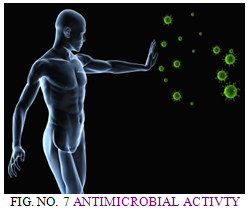
Psidium guajava leaves have long been recognized for their antimicrobial activity. the phytochemical analysis was observed that the Psidium guajava contains alkaloids, flavanoids, phenols andtannin which may either individual or in combination are responsible for the antibacterial activity. From the observed results, it could be concluded that Psidium guajava leaves could serve as good source of antibacterial and antifungal agents.
In vitro antimicrobial activity against Escherichia coli, Salmonella typhi, Staphylococcus aureus, Proteus mirabilis, and Shigelladysenteria . the effectiveness of the leaf extras against Staphylococcus aureus also found. It was shown to strong antibacterial activity and in addition to Staphylococcus aureus was also useful against Streptococcus spp. The leaves are rich in tannin, and have antisepticproperties.
A strong antimicrobial action of guava leaves on Gram-positive and Gram-negativeorganisms has been reported and also noted action on Mycobacterium phlei. The flavones derivatives isolated were reported to inhibit the growth of Staph. aureus in a dilution of 1:10,000.The bark was also shown to exhibit antibacterial, it might be , the effectiveness of Guava as an antimicrobial was confirmed by Four antibacterial compounds were isolated from leaves of guava (P. guajava) new flavonoid glycosides, morin-3-O-α-L-lyxopyranoside and morin-3-O-alpha-L are abopyranoside, and two known flavonoids, guaijavarin and quercetin.
Psidium guajava and bark tincture was subjected to invitro sensitivity test by serial dilution at concentration ranging from 5% to 15% against six test dermatophytes viz. Trichophyton tonsurans, T. rubrum, Trichosporon beigelii, Microsporum fulvum, M. gypseum and Candida albicans. Bark tincture has higher efficacy in controlling the mycelial growth of dermatophytes than the leaves tincture. The tincture showed fungicidal property in different concentrations but exhibited only fungistatic property in case of C. albicans. A leaf extract enters into a Nigerian remedy for skin infections, and examination showes positive action on gram positive microbial organism as well as on gram negative microorganism but less than action on gram positive microbes. Three antibacterial substances have been detected in the leaves which are derivatives of quercetine. As in the polyphenols and many other substances are present.
This antimciriobial property of psidium guajava linn. Useful for-
- developing topical antimicrobial agent .like(soaps, antiacne cream, lotion)
- Antiseptic.
- Mouth ailments (dental queries,antiplaque)- mouthwashes
- Vaginal discharge
-
In treatment of infantile rotaviral enteritis
ANTIDIARRHOEAL ACTIVITY
About 2.2 million people in developing countries are suffering from diarrhea. aqueous extract of the leaves of Psidium guajava L. were assessed for the antidiarrhoeal activity in male Sprague-Dawley rats with morphine as the standard drug (dose: 0.2 ml/kg). Quercetin and quercetin-3-arabinoside, extracted from the buds and leaves of Psidium guajava L. at concentrations of 1.6 μg/ml showed a morphine like inhibition of acetylcholine release in the coxially stimulated ileum together with an initial increase in muscular tone, followed by a gradual decrease. It is also reported that the Asiatic acid, extracted from the leaves showed dose dependent(10-500 μg/ml) spasmolytic activity in spontaneously contracting isolated rabbit jejunum.
In a study carried out with methanol extract from leaves (8 μg/ml) of Psidium guajava showed activity against simian (SA-11) rotavirus 93.8% inhibition. In addition, galactose specific lectin in guava was shown to bind to Escherichia coli (a common diarrhea causing organism), preventing its adhesion to the intestinal wall and thus preventing infection resulting diarrhea.
Researches showed that the guava has potent antidiarrhoeal activity like that morphine ,but we well know that the side effects of morphine (which is very dangeres) in that case PSIDIUM GUAJAVA LINN. is hold greater importance because of its negligible toxicity as well as potent effect. the isolated compounds are used in pharmaceutical.
ANTIDIABETIC ACTIVITY
Psidium guajava is one of the most widely used plant as herbal remedy for the treatment of Diabetes mellitus. In the present study the hydro alcoholic extracts of the fresh and dry leaves of this plant are therapeutically evaluated and compared for anti-hyperglycemic potential against Alloxan induced Diabetes in Rats. The animals were administered with doses of 500mg/kg body weight of extract orally to Alloxan induced rats continuously for 30days, caused significant reduction in the fasting serum blood glucose levels. Among the two extracts fresh leaf extract showed significant anti hyperglycemic activity than the dry leaf extract which nearly produced equal reduction in serum blood glucose levels to that of standard glibenclamide 10mg/kg.
Studies revealed that the plant contains good anti-diabetic potential, with increase in the body weights of the animals. As per the literature review the plant also contains anti-oxidant properties . So free radical scavenging property exists for the compound which may play a key role in minimising the microvascular and macrovascular complications of diabetes mellitus.
NOW YOU CAN ALSO PUBLISH YOUR ARTICLE ONLINE.
SUBMIT YOUR ARTICLE/PROJECT AT articles@pharmatutor.org
Subscribe to Pharmatutor Alerts by Email
FIND OUT MORE ARTICLES AT OUR DATABASE
The decoction of leaves was screened for hypoglycaemic activity in alloxan induced diabetic rats. In both acute and sub acute tests, the extract showed statistically significant hypoglycaemic activity. apart from these the treatment with Psidium guajava L. aqueous leaf extract (0.01-0.625 mg/ml) also showed significant inhibition on LDL glycation in a dose-dependent manner. Tannins, flavonoids, pentacyclic triterpenoids, guiajaverin, quercetin and other chemical compounds present are speculated to account for the observed hypoglycaemic and hypotensive effects of the leaf extract.
Whatever the case may be, the undisputable truth is that this subject requires further investigations. Psidium guajava is an excellent anti-LDL glycative agent whose potential therapeutic uses can been extended to the prevention of a variety of cardiovascular and neurodegenerative diseases associated with glycations. Some investigators suggested that the hypoglycaemic components of guava fruits might involve ursolic acid, oleanolic acid, arjunolic acid and glucuronic acid. the antiglycation activities of guava fruit were relevantly and directly related to its polyphenolic content (extractable polyphenols 2.62-7.79%).
CARDIOVASCULAR SYSTEM AFFECT

Psidium guajava has been reported to have action on the heart. In a study of an aqueous leaf extract, Psidium guajava L. exhibited cardioprotective effects against myocardial ischaemia-reperfusion injury in isolated rat hearts. Ojewole, (2005) showed that an aqueous leaf extract caused hypotension in the experimental animal model used via cholinergic mechanisms. the acute intravenous administrations of the leaf extract produced dose dependent, significant reductions in systemic arterial blood pressures and heart rates of hypertensive. Belemtougri et al (2006) found that an aqueous and ethanolic leaf extracts of Psidium guajava L. inhibits intracellular calcium release.
An Aqueous leaf extract of Psidium guajava L. significantly and dose-dependently (0.25-2mg/ml) contracted theaorta rings. the sensitivity of the aortic rings to cumulative doses of Psidium guajava L. was significantly enhanced in the presence of phentolamine suggesting that the effect of Psidium guajava L.was to a large extent mediated by activation of an alpha-adrenoceptor and to a lesser extent by activating via calcium ion channels.The antihypertensive effect was also observed on the pink guava puree.
Psidium guajava Linn leaf is used traditionally in Indian medicine to control hypertension in human. the aim of this work was to study the hypotensive effect of Psidium guajava Linn. leaf extract in human. hypertension is due to the activity of the angiotensin-Converting Enzyme that catalyzes the conversion of the inactive Angiotensin I to the active Angiotensin II. Angiotensin II functions as a potent vasoconstrictor causing hypertension. Hence, ACE inhibitors are considered to be the first choice treatment of hypertension. The ACE inhibitory activity of Psidium guajava Linn. leaf extract in human was studied by its in vitro inhibitory effect on human serum-ACE using the substrate FA-PGG (N-(3-(2-Furyl) acryloyl)-Lphenylalanyl- glycyl-glycine). The enzyme kinetics of ACE inhibition was investigated by Michaelis–Menten kinetics and Lineweaver–Burk graph and Vmax and Km values were calculated. The results show that there is a decrease in both Vmax and Km values in the presence of Psidum guajava leaf extract. The decreased Vmax and Km seen with Psidium guajava indicates that Psidium guajava binds to other alternative sites rather than the active site of the ACE and hence the inhibition is uncompetitive. The decreased Vmax/Km value indicates decreased catalytic ability/affinity of enzyme-substrate due to the presence of the inhibitor Psidium guajava leaf extract. From these we could conclude that P. guajava Linn leaf extract inhibit human serum-ACE uncompetitively and it has hypotensive effects in human.
ANTIPROLIFERATIVE ACTIVITY
Anti-proliferative activity of essential oil from 17 Thai medicinal plants on human mouth epidermal carcinoma (KB) and murine leukemia (P388) cell lines using MTT assay were investigated. An amount of 1/104 cells/well of KB cell line and 1/105 cells/well of P388 cell line were treated with the oil samples at different concentrations ranging from 0.019 to 4.962 mg/ml. In KB cell line, Guava (Psidium guajava L.) leaf oil showed the highest anti-proliferative activity with the IC50 value of 0 .0379 mg/ml (4.37 times more potent than vincristine). The results demonstrated the potential of essential oil from Thai medicinal plants for cancer treatment.
Acetone extracts from guava branch (GBA) preparations were evaluated for their cytotoxic activity in HT-29 cells.As a preliminary test to confirm the cytotoxicity of GBA in HT-29 cells, the cells were pretreated with 50, 100, and 250 μg/ml GBA. HT-29 cells were originally derived from a human colon cancer and were chosen as representative hypovascular tumor. These cells had shown strong tolerance to anticancer agents in vitro and in vivo. We attempted to determine the cytotoxic activity of GBA and the cytotoxic effect of these extracts as measured by the MTT (3-(4, 5-dimethylthiazol-2-yl)-2,5,- diphenyltetrazolium bromide) reduction assay. GBA showed potent cytotoxic activity in HT- 29 cells. GBA effected a 30 - 70% reduction in cell viability as compared to the control, in a dose-dependent manner. In order to assess the cytotoxicity occurring in cells measured in the sub-G1 phase were approximately 30-fold greater for the GBA-treated HT-29 cells than for the control. These results clearly indicate that the anti-proliferative effect of GAE on HT-29 cells was attributable to apoptosis and suggest that guava branch may be an important natural anticancer chemotherapeutic agent.
In conclusion, it is clearly demonstrate that GBA significantly induces cytotoxicity and an increase in the sub-G1 phase of HT-29 cells. these results show that GBA may exert anticancer activity by the induction of apoptosis via inhibition of cell cycle. Therefore, our results suggest that GBA may be a potential candidate for a novel therapeutic agent in the field of anticancer drug discovery.
FUTURE PROSPECT
Psidium guajava L. will be a useful plant for developing newly therapeutic agent for herbal and pharmaceutical industries, since it was used traditionally in many countries with its wide therapeutic range, it shows that the different prospectes for researches in future .areas where researches are required for asure its therapeutic effects are –
· Anticancer activity
· Antidiabetic activity
· Antihypertensive activity
The cytotoxic capacity of the essential oils based on a pro-oxidant activity can make them excellent antiseptic and antimicrobial agents for personal use i.e. for purifying air, personal hygiene, or even internal use via oral consumption and insecticidal use for preservation of crops or food stock, recent studies have demonstrated that the pro-oxidant activity of some essential oil or some of their constituents, as also that of some polyphenols is very efficient in reducing local tumor volume or tumor cell proliferation by apoptotic and or necrotic effects. We have shown that the guava leaf essential oil has cytotoxic on the human cervical cancer cell lines have shown anticancer activities on KB and P388 cell lines. Many tumor cells are characterized by severe changes in energy metabolism and mitochondrial overproduction and permanent oxidative stress.
Essential oils due to their capacity to interfere with mitochondrial function, may add pro-oxidant effect and thus become genuine antitumor agent. Many radical producing agent are in fact used in antitumor treatments. in the case of essential oiles, redical production could be very well controlled and targeted without presenting by it any toxic or mutagenic side effects to any healthy tissues. Essential oils or their active constituents could be included in vectorized liposome that would allow bettering defining the quantities applied. Thus, the Psidium guajava L. essential oil could make their way into the modern medical domain. Machenism behind the anticancer activity , of psidium guajava l. is not known. pharmacological action of p.guajava l. is under study. and plant found to be very good activitites against cancerous cell as shown in therapeutic potential. but more estimations or elucidations are required .
Active factors of P. guajava fruits involve ursolic acid, oleanolic acid, arjunolic acid and glucuronic acid , saponin combined with oleandolic acid: morin- 3-O-a-L-lyxopyranoside and morin-3-O-a-Larabinopyranoside pentane-2-thiol and flavonoids: guaijavarin and quercetin. In comparison, huge amounts of b-sitosterol glucoside, brahmic acid, and polyphenolics (165.61 ± 10.39 mg⁄ g dried crude extract) including gallic acid, ferulic acid, and quercetin and flavonoids (82.85 ± 0.22 mg⁄ g dried crude extract) , and triterpenoids exist in guava leaves. Thus, it is clear that P. guajava contains many component sepereted to display efficacy against cancer.
Acetone extract was highly active against gram positive and fungal strains while all of the extracts were equally active against gram-negative strains. it is concluded that acetone extract of Psidium guajava is highly active against 74.72% of the total 91 microbial strains studied. The acetone extrac of P.guajava should further be studied for its phytochemical constituents in order to elucidate the active principle within the extract which can turn out to be a novel antimicrobial agent of the future.
CONCLUSION
Therapeutic potential of P.guajava, review presented numerous evidences of its strong antidiarrhoeal, antimicrobial, antioxidant and other so many activities. P.guajava L. has received much attention in the literature over the past 10 years and a variety of potential beneficial effects have been elucidate. it is imperative that more clinical and pharmacological studies should be conducted to investigate the unexploited potential of this plant.
Many essential oil components and extract of P.guajava L. have been screened for antiproliferative agents, and showen suppressive activity when tested on number of human cancer cell lines including colon cancer, gastric cancer, human liver tumor, pulmonary tumor, breast cancer, leukemia and others. In recent study , essential oil from the leaves of the plant was reported to exhibit anticancer activities on KB Aand P388 cell lines. it was reported that essential oil from the leaves of P.guajava exhibited the highest antiproliferative activity towards KB cells .
A survey of the literature shows P. guajava is mainly known for its antispasmodic and antimicrobial properties in the treatment of diarrhoea and dysentery. Has also been used extensively as a hypoglycaemic agent. Many pharmacological studies have demonstrated the ability of this plant to exhibit antioxidant, hepatoprotection, anti-allergy, antimicrobial, antigenotoxic, antiplasmodial, cytotoxic, antispasmodic, cardioactive, anticough, antidiabetic, antiinflamatory and antinociceptive activities, supporting its traditional uses. Suggest a wide range of clinical applications for the treatment of infantile rotaviral enteritis, diarrhoea and diabetes. Wide range of therapeutic potential of psidium guajava linn has been reported which has many useful pharmaceutical applications.
REFERENCES
1. *S. Buvaneswari, , C.K.Raadha, N.Krishnaveni, S.Jayashree;in vitro antimicrobial activity of psidium guajava against clinically important strains;2011 EJLS.
2. B. joseph and mini priya R; in vitro antimicrobial activity of psidium guajava l. leaf essential oil and extract using agar well diffusion method;2010; international journal of current pharmaceutical research.
3. Meenu Mehtaa, Saurabh Satijaa, Vandna Kalsia*;Invitro Antioxidant evaluation of Psidium guajava strem extracts;2011; International Journal of Drug Development & Research.
4. Sankar kumar Dey; Debdulal Benrjee;Sourav Chatopadhyay;krishnendu Bikash Karmakar; Antimicrobial activity of some medicinal plants of west Bengal; 2010 ; International journal of pharma and bio science.
5. Meenakshi Vaidya; Phytochemical Screening & Antibacterial activity of aqueous & methanolic extract of Young & Mature leaves of Psidium guajava L. (guava);2012;IJGHC.
6. P. Bontempo*, A. Doto*, M. Miceli*,L. Mita*, R. Benedetti*, A. Nebbioso*, M. Veglione*, D. Rigano§, M. Cioffi*,V. Sica*, A. M. Molinari* and L. Altucci*; Psidium guajava L. anti-neoplastic effects: induction of apoptosis and cell differentiation;2011; Cell proliferation.
7. Sang-Bong Lee1 and Hae-Ryong Park; Anticancer activity of guava (Psidium guajava L.) branch extracts against HT-29 human colon cancercells;2010; JMPR.
8. Narayan P. Gavatia, Mukul Tailang, Bhaskar K. Gupta, Eman A. Subhey, Alkesh K. Lokhande , Narendra Vyas; Therapeutic potential of Psidium guajava and its polyherbal formulation on chemotherapyinduced alopecia;2011; Journal of pharmacy research.
9. Girish Kumar Gupta*, Jagbir Chahal, Deeksha Arora; Psidium guajava Linn: Current Research and Future Prospects;2011; journal of pharmacy research.
10. Elekwa*, S. C. Okereke and B. O. Ekpo; Preliminary phytochemical and antimicrobial investigations of the stem bark and leaves of Psidum guajava L.;2009;JMPR.
11. Sadiq Yusuf, Abdulkareem Agunu, Nna Venessa Katung and Uduak E Umana; Ethanolic Leaf Extract of Psidium Guajava L. [Myrtaceae] Protects the Stomach against Ischemia;2010;Asian journal of medical sciences.
12. D.A. Akinpelu and T.M. Onakoya; Antimicrobial activities of medicinal plants used in folklore remedies in south-western;2006;African journal of biotechnology.
13. Jairaj, P., Khoohaswan, P., Wongkrajang, Y., Peungvicha, P., Suriyawong, P., Saraya, M.L.S and O. Ruangsomboom ., 1999. Anticough and antimicrobial activities of Psidium guajava Linn. Leaf extract. Journal of Ethnopharmacology.
14. Padula, M and Rodriguez?Amaya, D.B, 1986. Characterisation of the carotenoids and assessment of the vitamin a value of Brasilianguavas (Psidium guajava L.). Food Chemistry.
15. Nenad Vukovic, Tanja Milosevic, Slobodan Sukdolak and Slavica Solujic. Antimicrobial Activities of Essential Oil and Methanol Extract of Teucrium montanum. Oxford Journal OF Medicine.
NOW YOU CAN ALSO PUBLISH YOUR ARTICLE ONLINE.
SUBMIT YOUR ARTICLE/PROJECT AT articles@pharmatutor.org
Subscribe to Pharmatutor Alerts by Email
FIND OUT MORE ARTICLES AT OUR DATABASE











.png)

